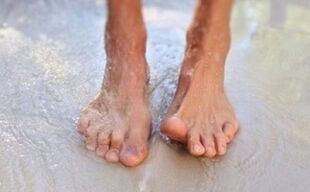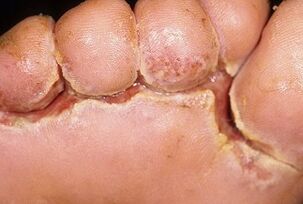Approximately 80% of the population is affected by skin fungi. Due to increased density and sweating, fungal diseases are more susceptible to the skin of the feet. Fungal infections are manifested by peeling and itching, but they can also be asymptomatic and only cause the appearance of seals (calluses, corns-hyperkeratosis on the heel and arch). If left untreated, the infection can spread. Patients can infect others and spread the germs throughout their body.
Where does the fungus come from

Fungal microorganisms like humid and warm environment and rich nutrition. As a "shelter", they use dense skin, which tends to increase the secretion of fat and sweat.
Human feet-has always been a favorable breeding ground for mycobacteria, and inferior socks and shoes can also cause this situation.
You can get infected in public places-on the beach, in the sauna, in the swimming pool. An infection may occur when trying on new shoes, because people with foot fungal disease can measure it the day before.
Some internal factors also increase the susceptibility to fungi:
- Weak immunity-fungi reject the body's defenses, when they are weakened, microorganisms are more likely to penetrate the skin;
- Endocrine disorders-Diabetes and hormonal disorders can change the composition of skin secretions, making them a breeding ground for bacteria;
- Persistent damage-cracks, scrapes, scratches and punctures may be fungal entrances;
- Lack of hygiene-poor quality foot washing, the use of dirty socks and airtight shoes can cause fungal invasion in the limbs.
Infections can also come from relatives-if there are patients or fungal carriers with asymptomatic disease in the family. The controversy of pathogenic microorganisms spread to household appliances, personal belongings, gender (if the patient moves barefoot). When washing all household items, mycobacteria can contaminate the clothes of healthy family members. They not only cause fungal diseases on the feet, but also cause fungal diseases on other parts of the body (folds, groin, hairy areas).
Why does fungus appear between the fingers
Interdigital fungus is a special clinical form of foot mycosis. Doctors call it intertriginous. During this process, the skin will be affected between 3 to 4 or 4 to 5 toes. Usually, the pathological process starts from one side and eventually spreads to the healthy side.

Mycosis begins with cracks in the skin between the toes or at the base of the phalanx of the foot. The size of the wound can vary from 2-3 mm to 1 cm. The intensity of the symptoms depends on the size of the wound-the larger the wound, the stronger the pain. When cracks appear, people will feel a slight discomfort while walking, and this discomfort will increase with the increase of sanitation procedures.
Unlike other injuries, cracks do not heal on their own. It will be inflamed and ooze fluid. The surface between the fingers gets wet, which further helps the fungus spread to a larger area of skin. A "stripe" appeared around the wound-it was steamed skin. The detachment is quite thick, and trying to remove it with your fingers can cause injuries to healthy areas of the skin. Persistent peeling occurs around the lesion. It can be layered or powdered. The scales are silver, white, and light yellow. These characteristics depend on the fungal strain that infects the skin. After the cracks heal, the special form of fungal disease becomes scaly-it manifests as a large dry area of the foot with a large amount of sloughing scales. The surface can be shiny or structured.
What to do with fungal symptoms
If you have cracks between your fingers and are surrounded by loose skin, you should definitely see a dermatologist. The expert will conduct an examination to determine the symptoms not only in the injured area, but also in other parts of the limb.
Symptoms alone cannot make a diagnosis. A microscopic examination of the skin scraped from the feet is required to confirm the fungus. In the case of drug-resistant fungal diseases, PCR analysis or culture inoculation is supplemented to determine the type of pathogen and its sensitivity to bactericidal drugs.
In advanced cases with extensive fungal or dermal lesions, systemic medication will be required. Because these drugs may have liver and nephrotoxic effects, patients should undergo blood and urine tests. Based on their results, experts assess the function of vital organs and choose a systemic antifungal treatment plan.
Self-medication for foot fungal infections is only allowed in the early stages. You can use topical medications that do not cause systemic side effects.
Effective remedy for interdigital fungus
The characteristics of treatment depend on the patient's individual data, the degree of fungal disease, the area of the lesion, the presence of secondary infection or the resistance of the pathogen.
Systemic medication
To speed up the treatment and make it complete, the doctor will prescribe antifungal drugs in the form of tablets or capsules.
When using drugs with systemic effects, it is not advisable to consume alcohol, high-fat foods and other foods that load the liver. If the infection has spread from the interdigital space to the nail, it will take longer to use antifungal drugs.
Local remedy
For the treatment of interdigital fungus, the medicine is prescribed on a moderately or non-greasy basis (cream, solution). Ointment can only be used in the initial stage when the skin needs to be softened to heal the lesions quickly. In this process, antifungal drugs can be used as therapeutics and preservatives. They speed up the regeneration process and additionally soften rough skin.
For the treatment of foot fungus, an external agent with a broad-spectrum bactericidal ingredient is prescribed. Applies to products based on the following products:
- Terbinafine
- Clotrimazole;
- Ketoconazole;
- Econazole;
- Naftifina.
The price does not affect the success of the treatment, it is important to choose the correct active ingredient of the drug.
After the sanitation procedure, apply creams and solutions to the skin 1-2 times a day. After processing, let the product fully absorb and wear cotton socks. At the same time, it is necessary to disinfect the shoes every 3-7 days. For this, use fungicidal sprays. Socks, underwear, and towels need to be changed regularly. The used items must be separated from other accessories of the patient and his family and cleaned at high temperature.
For trichophyton and microsporosis, doctors will recommend special treatment options. For example, treatment with iodine solution in the morning and sulfuric acid, sulfur tar or salicylic acid ointment in the evening.
Folk remedies
You cannot treat the fungus only through folk methods. In addition to taking medicine, bathing is also allowed. If the doctor recommends the use of homemade ointments or preparations, they should be used separately from pharmaceutical preparations. For example, in the morning and evening, use ready-made medicine, in the afternoon-homemade ointment. The most popular way to treat fungus:
- Oak bark bath-Use oak bark to make a large amount of broth (6 tablespoons per 1 liter), dilute half with water, and bathe for 15 minutes every day;
- Use sea salt-Prepare a concentrated sea salt solution, take a bath for 10 minutes, do not wash off the salt, and put on cotton socks immediately after the operation;
- Add soda-Dilute one tablespoon of soda water in 1 liter of water, take a bath for 15 minutes, after wiping, apply medicinal antifungal agent;
- Egg ointment-Mix 1 egg with 1 tablespoon of oil and vinegar, stir until smooth, leave it under the bag for 3-4 hours, and wash off with water;
- Tea tree-The area affected by the fungus should be lubricated with tea tree oil and washed off after 3 hours. Dilute the oil by half with neutral fat sensitively.
Rejecting sweets, alcohol and high-fat foods can help cure the fungus quickly. The patient’s diet should contain a lot of vegetables, fermented dairy products, and whole grains.
To prevent fungus from appearing on your feet and toes, you should pay attention to foot hygiene. When going to any public place, avoid walking barefoot and use anti-fungal methods-apply any anti-fungal ointment or spray after showering. New shoes should only be measured with new socks; you should not give your slippers to anyone.
























